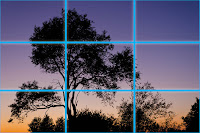Composition and the Rule of Thirds
When it comes to taking better and/or more interesting photographs, learning about composition and the rule of thirds will give you a boost towards capturing them, that no increase in equipment quantity, quality or simply how many photographs will take can provide. This tutorial was written to help, alongside some photographs, understand when and when not to apply the "Rule of Thirds" to composing your images.
What is the Rule of Thirds
The rule of thirds (image of its overlay above) is a visual rule for composing visual scenes which states that a image is most pleasing to the human viewer when the subjects, zones, or regions are composed in the image along imaginary lines. These lines bisect the image into nine quadrants or sections. It is seemingly counter-intuitive to apply such a mathematically precise type of rule to the 'image arts', but it works very well for the subjective field. The composing of subjects or scenes with the focus being along the lines and at their intersections creates a sense of balance in the image, and can be used to draw out motion, perspective, size and volume emotionally in the viewer. This rule allows for making a photo not too static and not to visually complex and busy.
The Rule of Thirds in use
So you can see how to overlay the rule of thirds mentally when composing a scene, below are some examples of the rule of thirds in use, to explain why and how it works in action.
The focus of this photograph is the tree sapling on the rock cleft, its positioning towards lower right corner on the intersection of the first horizontal line and the second vertical line of the rule of thirds grid is attractive to the viewer. The shadow to the right of the tree is balanced into taking a third of the photo approximately which compliments feeling the sapling is jutting out on it's own.
The rule of thirds is easier seen applied to this photograph with the lines of composition trisecting the photograph into thirds. The lines of division divide the solid sky, from the foggy trees, from the less-foggy more-clear foreground. This creates pleasing planes of composition for the images horizon.
As stated above, the rule of thirds can be used to cause the viewer to experience greater feelings of motion when looking at your photographs. In the photo above, the waters route from the upper right corner of the photograph to the bottom left corner, paints a track for the eye to follow when viewing and in that, provides more visual action perceived.
Sometimes however, you may want to showcase symmetry or a static image and have your subject in the center of your photograph. This is OK! The rule of thirds is meant to be broken, in the above image the rule of thirds is both broken and used at the same time. The suns rise between the buildings, being the central focus of the photograph, captures the viewers eye and then brings it down to the intersection through the street car lines. The eye then meets the stopped car and cross-walking man on the road, which provides more interest. This is just our example of breaking the rule, we trust you'll have no problem violating it yourselves to get better images, it is just another tool in your photography utility belt.
If your liking what your reading here, give my flickr page a look, and/or follow me on your favorite social network.
Facebook: http://www.facebook.com/shutterscience
Twitter: https://twitter.com/shutterscience






No comments:
Post a Comment